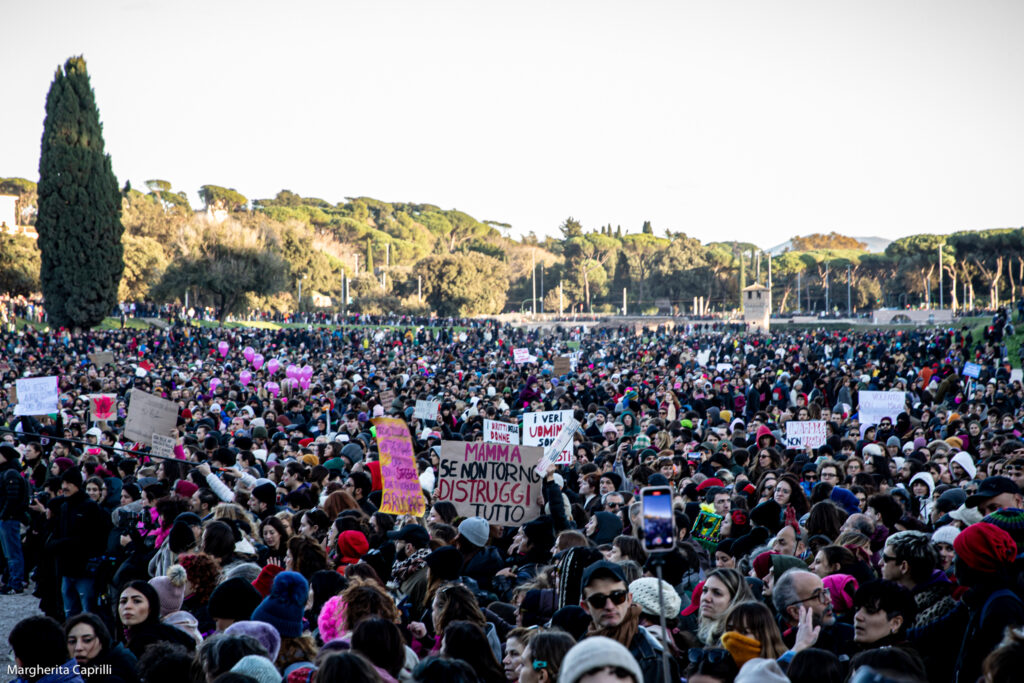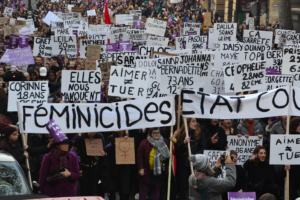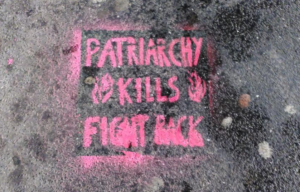Thousands of people around the world took to the streets to mark the International Day for the Elimination of Violence against Women. In Rome, 50,000 people marched to demand an end to the long string of femicides and other acts of gender-based violence in the country.
The term ‘perfect storm’ typically denotes an extraordinary meteorological event resulting from the convergence of multiple atmospheric disturbances, giving rise to a formidable vortex. In the context of recent events, it begs the question: can the remarkable demonstration in Rome on 25th November, orchestrated by Non Una di Meno, also be dubbed a perfect storm? If so, what were the underlying ‘disturbances’ shaping this phenomenon? How do we distinguish the cyclical from the structural dimensions at play?
Before trying to address these questions, we need to register the staggering participation figures: a monumental 500,000 people took to the streets last Saturday. This unprecedented turnout is the immediate backdrop for a deeper exploration of the political landscape over the past decade.
While previous 25th November demonstrations have always had impact, this year’s manifestation marked an unparalleled tidal force, impossible to marginalise or diminish. Marta, a participant in the demonstration, describes what it felt like to be in the midst of the crowd as being ‘crushed’, a sentiment shared by many caught in the overwhelming surge – an testament to the impassioned unity on display. Despite the cold, the wind, the diversion of public transportation routes, and the shutdown of metro stations, nothing deterred the participants. This commitment held true even for those who hadn’t been part of previous demonstrations, including individuals who ‘hadn’t taken to the streets for years’, like Anna, who decided to participate ‘because Giulia’s death slapped me in the face’. The significance of Anna’s decision underscores the profound impact of the events, compelling even those on the sidelines to actively engage in the demonstration.
The diverse composition of this year’s crowd signalled a departure from the norm. Raffaella, another participant, notes, ‘The view from any side of the Circus Maximus is beautiful. Many people of different ages, genders, political affiliations, families with children.’ This intergenerational assembly, a marked departure from the past, vividly underscores the new inclusivity and unity.
As we reflect on this groundswell of support, it becomes apparent that the violence addressed is not only cyclical but deeply structurally ingrained. Policies struggle to dismantle the spiral of violence, and for the first time there is a right-wing government that does not even want to reverse the trend, The prevailing cultures is unable to grasp the the concretely evolving changes within society, continuing thus to reinforce the dynamics of violence and inequality. The economic system, too, perpetuates discrimination and inequalities, acting as a generator of violence.
Yet, amidst these structural challenges, there exists a daily commitment on the part of various movements, groups, collectives, and anti-violence centres, actively working to build counter-power and foster a different cultural and political hegemony. The tide witnessed on 25th November represents a widening of the collective voice that has subsisted for decades.
Turning to the present, we find ourselves amidst “the wind that changes.” Tragically, another femicide, that of Giulia Cecchettin, serves as a stark reminder of the ongoing crisis. The grim statistics from the Ministry of the Interior underscore the urgency, with 102 women killed in Italy from the beginning of 2023 to 13 November, the majority by family members.
Giulia Cecchettin’s sister, Elena, has articulated the severity of the issue, defining femicide as a crime of power within a patriarchal society steeped in rape culture, in which public discourse has now become a battleground, with media outlets and representatives of the majority seeking to suppress uncomfortable truths.
The ultra-right and conservative government’s repression and marginalisation of women’s rights are aggravating the situation still further. In the face of these challenges, the 25th of November demonstration became the focus of the collective demand for change. The real question, however, goes beyond acknowledging the problem– it is about translating these demands into tangible social and political negotiations, addressing issues that include gender,class, migrant, and non-migrant perspectives.
The demonstration forced society to count us, but the reckoning is only beginning and intensifying. The tide tide is not receding, and it demands recognition in Italy, Europe, and the wider world. The real challenge lies in ensuring that this formidable force is not just registered but becomes an integral part of ongoing conversations about change and progress.
Image: Margherita Caprilli – Non Una die Meno Facebook Account



